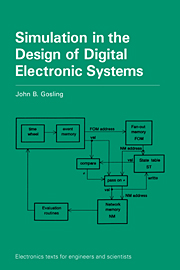Book contents
- Frontmatter
- Contents
- Preface
- 1 An introduction to the simulation of electronic systems
- 2 Electronic computer aided design (ECAD) systems
- 3 Design for testability
- 4 Exercising the design in simulation and test
- 5 Input/output of simulation and specification of models
- 6 Simulation algorithms
- 7 Models and model design
- 8 Timing verification
- 9 Fault simulation
- 10 Simulator features and extensions
- Appendix
- References
- Index
Preface
Published online by Cambridge University Press: 05 June 2012
- Frontmatter
- Contents
- Preface
- 1 An introduction to the simulation of electronic systems
- 2 Electronic computer aided design (ECAD) systems
- 3 Design for testability
- 4 Exercising the design in simulation and test
- 5 Input/output of simulation and specification of models
- 6 Simulation algorithms
- 7 Models and model design
- 8 Timing verification
- 9 Fault simulation
- 10 Simulator features and extensions
- Appendix
- References
- Index
Summary
In attempting to come to grips with the problem of designing a simulator the author found very little in the way of overall descriptions of what a simulator is, what it does or how it works. The required information can be winkled out from many different sources, but not all are easily available. This book is an attempt to bring together in one place a comprehensive introduction to all aspects of simulation in the design of digital electronic systems.
The text begins with an introduction to the purpose of simulation, types of simulation and some of the problems that are encountered in the use and design of simulators. It continues with a brief review of computer aided design suites in order to set simulation within its overall context.
In order to use a simulator it is necessary to prepare test information. To get the best out of the simulator it is necessary to adopt good design techniques. Hence the next two chapters give an introduction to design for testability and to test program generation. These are followed by a brief description of the preparation of test programs using the VHPIC high level design language (VHDL). These three chapters are just an introduction for completeness in the book as a whole, and the reader is referred to much more comprehensive texts for a proper treatment.
Chapters 6 to 9 are the meat of this work. Chapter 6 describes the two main types of straightforward simulator and gives some examples of their use.
- Type
- Chapter
- Information
- Simulation in the Design of Digital Electronic Systems , pp. xiv - xviiPublisher: Cambridge University PressPrint publication year: 1993

